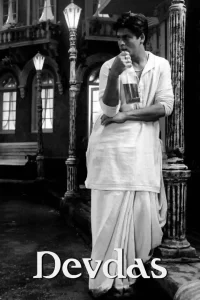
Set in feudal Bengal of the early 20th century, Chattopadhyay’s Devdas explores the age-old dichotomy between social norms and human desires. The cultural impact of Devdas is so immense that it has attained a metaphorical/symbolic value. The “Devdas Syndrome” is so deep-rooted in the Indian psyche that Chattopadhyay’s hero has become mythical. It represents a masochistic, self-destructive, obsessed lover who is often glorified as a romantic rebel. Chattopadhyay’s archetypal hero and his tragic tale have been adapted on screen several times in several eras with new “elements of reality” dependent on the changing socio-political backdrop. However, in every version, the male gaze, the entitlement of Devdas, and the plight of women remain unchanged.
In the original book, the childhood friendship between Devdas and Parvati is filled with male arrogance and entitlement. Ever since childhood, Paro is expected to not only obey Dev’s orders but also save him from trouble. In one scene, Devdas, out of anger, beats Paro with a stick. When asked about her wounds, she lies to her family and frames her teacher. It is decided that she won’t attend school anymore, since she is going to get married eventually. Dev’s family refuses their marriage proposal as Paro belongs to a trading lower family. Parvati’s family follows the long-standing tradition of accepting dowry from the groom’s family for marriage rather than sending dowry with the bride. In other words, the woman is a commodity sold by her family and purchased by the groom’s family during the marriage. The tradition of giving bride dowry is practiced in many Asian countries, the Middle East, parts of Africa, and some Pacific Island societies. Chattopadhyay’s 13-year-old Paro is eventually married to a 40-year-old widower with three children. However, before her marriage, she walks into Dev’s chamber at midnight to ask him to marry her, defying societal norms. This action wasn’t just unusual but also brave for women during that time, especially a woman whose marriage was arranged with someone else. It was brave primarily because Paro, as per societal norms, doesn’t walk into Dev’s chamber alone. She carries her family’s honor with her.
When the book was written and published, the colonial Bengal society, at large, was influenced by the stereotypical construct of the “devi”, the ‘saintly, virtuous and dutiful’ women, especially upper and middle-class women. The construction of this image worked in two ways. A) It was a necessary correlate of national enterprise to challenge and defeat the West on moral grounds. B) The identity of “devi” separated women of the lower classes of Bengali society – the maidservants, washerwomen, prostitutes, etc., whom Uma Chakravarti labels “dasis”. This dichotomy between “devi” and “dasi” plays an important role in Devdas and is represented through the characters of Paro and Chandramukhi. This is best highlighted by these lines spoken by Bhansali’s Devdas to courtesan and sex-worker Chandramukhi, “Tum aurat ho Chandramukhi, pehchaano apne aap ko. Aurat maa hoti hai, bhen hoti hai, patni hoti hai, dost hoti hai, Aur jab wo kuch nhi hoti, tawaif hoti hai. Tum kuch or ban skti ho, Chandramukhi.”
The image of “devi” is a patriarchal society’s obsession with purity associated with a woman who is always defined in terms of her relations with men in her life and is never seen as an individual. In the absence of this patriarchal purity, she isn’t only robbed of her individuality, which she never possessed in the first place, but is also labeled as a slut, prostitute, etc. as an insult. Even the most subtle portrayal of a woman usually presents her as the guardian of culture and religion or the embodiment of purity and spiritual power. Yet, she constantly requires the patriarch as her lord, master, and savior. Chattopadhyay’s Paro and Chandramukhi represent two set of stereotypes women face in a patriarchal society, emphasizing that there’s no escape. Despite contrasting social positions, Chandramukhi and Parvati act as mirror images of each other in every version of Devdas. Both women suffer from the “I can fix him” complex and serve a single purpose – taking care of Devdas, servicing him, and sacrificing for him. In every version of the film, the similarities between the actresses playing the roles of Paro and Chandramukhi in Devdas’s life are unmistakable. Nor are these similarities lost on Devdas.
The 2002 opulent version of Devdas, directed by Bhansali, glorifies the toxic relationship of Dev-Paro. Bhansali’s Devdas, played by Shah Rukh Khan isn’t just more likable than the original Devdas but also more tragic and, hence, succeeds in getting sympathy from the audience. While in the original book, Chattopadhyay makes sure the downfall of Devdas and his relationship with Paro come across primarily as his fault, Bhansali brilliantly shifts the blame onto the family plagued with stereotypical women who gossip, initiate drama, and are greedy. Unlike Chattopadhyay’s Dev-Paro, Bhansali’s Dev-Paro aren’t teenagers. The scene where Devdas hits Paro’s forehead and gives her a scar to remember him by is romanticized followed by a heartbreaking song. Throughout the movie, “tawaif” is used as an insult, and Chandramukhi is despised by Devdas for not being a “devi” and for not being ashamed of it. Bhansali in an interview says, “…there is a Devdas on every street. I honestly feel that this character exists in every male, especially every Indian male.” One must wonder if every Indian male is a Devdas, how long can we oversee the plight and labor, often labeled as fate or bravery, of Paros and Chandramukhis in Indian society?
Kashyap’s Dev.D (2009), infused with edgy realism, starring Abhay Deol is a modern-day ironic take on Devdas. Unlike Chattopadhyay’s and Bhansali’s tales of asexual love where Paro and Chandramukhi are eventually merged into one, Kashyap uses sexuality as a tool. His characters are unapologetically sexual beings and they aren’t ashamed of it. As soon as the movie begins, we see Paro going out of her way to send her topless picture to Dev, despite belonging to a conservative Punjabi family. They get intimate as soon as they meet. The devi image of Paro is dismantled right from the start. Thrown out of Bhansali’s glass mansions, we find ourselves in Kashyap’s gritty alleys. Paro isn’t a devi and his Chanda isn’t a dasi. In Chattopadhyay and Bhansali, Devdas is known for his unwavering dedication to his Paro, despite having flaws. There is a flawed hero and flawed love, but never the flawed dedication. The name Devdas, composed of two words, Dev and Das, means “the servant of God” or “devotee of God”. For Devdas, in Chattopadhyay and Bhansali, Paro remains a deity he seeks even in his dying moments. But Kashyap’s Dev cheats on Paro as he is a sex maniac. He rejects Paro due to his whims and then regrets it later. Paro doesn’t burden herself with the responsibility to fix Dev. Her life doesn’t revolve around him and she eventually moves on to a new life. Kashyap’s women can be seen as individuals who make certain choices for themselves, good or bad. Through the character of Chanda, Kashyap even explores some pertinent gender issues. For instance, how underage or teenage girls are preyed on by adults and become victims of the patriarchal society. Unlike men, they are expected to uphold the family’s honor. The vital scar scene in other versions is almost reversed in Kashyap. In Dev-D, it is Dev who gets a scar on his forehead when he breaks the glass, highlighting how it is him, not the women around him, who would be scarred due to his actions and face consequences for the same. Kashyap is less sympathetic to his hero. While Devdas dies in other versions, Kashyap’s Dev lives to face the consequences of his actions. Dev’s final words to Chanda/Lenny, ” I am a slut” subvert the dynamics between Devdas and Chandramukhi. While Bhansali’s film focuses on Devdas as the protagonist, everyone else orbiting around him; Kashyap’s Lenny/Chanda, the dasi of Devdas Universe, can be considered the protagonist. However, Bhansali’s statement “…there is a Devdas on every street…this character exists in every male, especially every Indian male” remains an undeniable truth as we see yet another Deol’s Dev display picture on Instagram, glorifying him and aspiring to be as cool as him. Even though Kashyap tried his best not to glorify his toxic hero, the audience surely did. The cautionary tale becomes tragic, yet again, because such is the cultural impact of this mythical hero. Devdas could die in every universe, but his legend lives on.
Ayushi Kainthola is a literature postgraduate with a keen interest in exploring cultural narratives and societal dynamics through academic research, focusing on gender studies and identity politics.




Leave a Reply